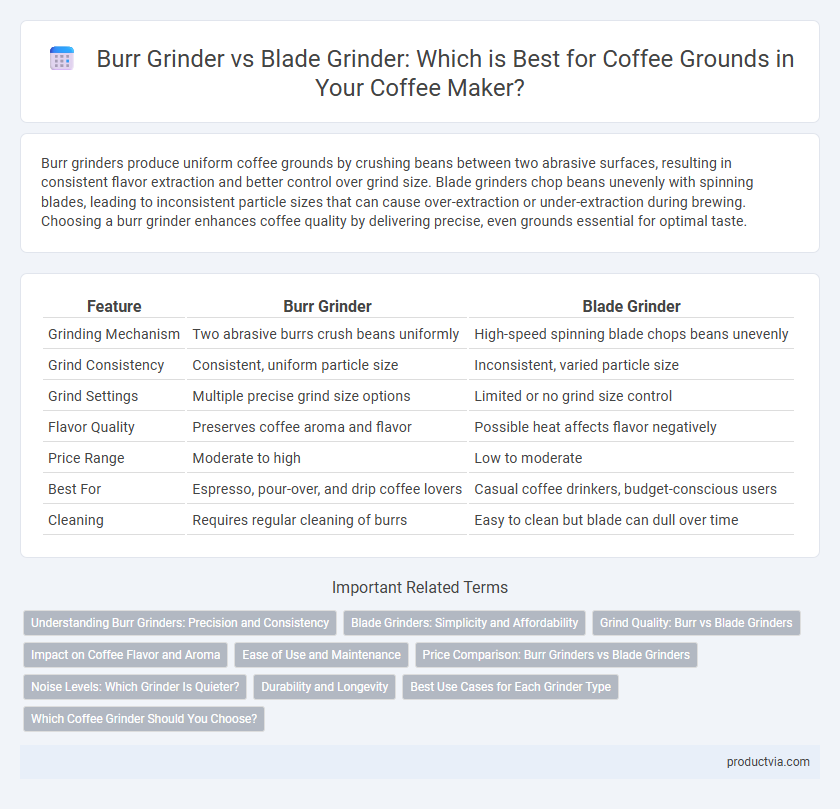Burr grinders produce uniform coffee grounds by crushing beans between two abrasive surfaces, resulting in consistent flavor extraction and better control over grind size. Blade grinders chop beans unevenly with spinning blades, leading to inconsistent particle sizes that can cause over-extraction or under-extraction during brewing. Choosing a burr grinder enhances coffee quality by delivering precise, even grounds essential for optimal taste.
Table of Comparison
| Feature | Burr Grinder | Blade Grinder |
|---|---|---|
| Grinding Mechanism | Two abrasive burrs crush beans uniformly | High-speed spinning blade chops beans unevenly |
| Grind Consistency | Consistent, uniform particle size | Inconsistent, varied particle size |
| Grind Settings | Multiple precise grind size options | Limited or no grind size control |
| Flavor Quality | Preserves coffee aroma and flavor | Possible heat affects flavor negatively |
| Price Range | Moderate to high | Low to moderate |
| Best For | Espresso, pour-over, and drip coffee lovers | Casual coffee drinkers, budget-conscious users |
| Cleaning | Requires regular cleaning of burrs | Easy to clean but blade can dull over time |
Understanding Burr Grinders: Precision and Consistency
Burr grinders utilize two revolving abrasive surfaces to crush coffee beans evenly, ensuring consistent grind size essential for optimal extraction. Precision in grind size adjusts brewing variables, enhancing flavor profiles and reducing bitterness. Unlike blade grinders, burr grinders prevent overheating, preserving the coffee's aromatic oils and resulting in superior cup quality.
Blade Grinders: Simplicity and Affordability
Blade grinders offer a simple and affordable solution for grinding coffee, ideal for beginner coffee enthusiasts. Their mechanism uses rotating blades to chop beans quickly, making them easy to operate and clean. Though less consistent in grind size compared to burr grinders, blade grinders provide sufficient performance for everyday brewing at a lower cost.
Grind Quality: Burr vs Blade Grinders
Burr grinders deliver consistent grind size by crushing coffee beans between two abrasive surfaces, ensuring uniform extraction and enhanced flavor clarity in brewed coffee. Blade grinders cut beans unevenly with a spinning blade, resulting in inconsistent particle sizes that can cause over-extraction or under-extraction, leading to a bitter or weak taste. For optimal grind quality, burr grinders are preferred by baristas and coffee enthusiasts seeking precise control over grind consistency.
Impact on Coffee Flavor and Aroma
Burr grinders deliver a consistent grind size, preserving coffee beans' flavor and aroma by avoiding overheating and uneven particle distribution. Blade grinders produce irregular grounds and generate heat that can degrade essential oils, resulting in a less rich and aromatic cup. Choosing a burr grinder enhances the extraction process, unlocking fuller, more vibrant coffee flavors.
Ease of Use and Maintenance
Burr grinders offer consistent grind size and are preferred for precise coffee brewing but require regular cleaning of burrs to prevent residue build-up. Blade grinders are easier to use with simple on/off operation and minimal maintenance, though they produce uneven grounds affecting flavor quality. For users prioritizing convenience, blade grinders provide straightforward use, while burr grinders demand more care but deliver superior grind consistency.
Price Comparison: Burr Grinders vs Blade Grinders
Burr grinders typically cost between $50 and $300, reflecting their precise grinding mechanism and consistent particle size that enhances coffee flavor extraction. Blade grinders, priced from $15 to $50, offer an affordable option but produce uneven grounds that can result in inconsistent brewing. Investing in a burr grinder usually provides better value for coffee enthusiasts seeking precise and uniform grounds despite the higher initial cost.
Noise Levels: Which Grinder Is Quieter?
Burr grinders produce less noise compared to blade grinders due to their precise grinding mechanism, which operates smoothly without the high-speed spinning blades that create louder sounds. Noise levels for burr grinders typically range between 50-70 decibels, whereas blade grinders can reach over 80 decibels, often disturbing quiet environments. Choosing a burr grinder ensures a quieter coffee grinding experience, preserving peace in a morning routine or shared space.
Durability and Longevity
Burr grinders offer superior durability and longevity compared to blade grinders due to their robust construction and precise grinding mechanism. High-quality burr grinders use hardened steel or ceramic burrs that resist wear and maintain consistency over time, ensuring a long lifespan. Blade grinders tend to wear out faster as their blades become dull and motor strain increases, leading to reduced performance and a shorter overall lifespan.
Best Use Cases for Each Grinder Type
Burr grinders deliver consistent, uniform coffee grounds ideal for espresso and pour-over brewing methods, where precision is crucial to flavor extraction. Blade grinders are best suited for drip coffee makers and French presses, offering a budget-friendly option for coarser, less uniform grinds. Choosing between burr and blade grinders depends on the desired grind consistency and brewing style for optimal coffee taste.
Which Coffee Grinder Should You Choose?
Burr grinders provide a consistent grind size by crushing coffee beans between two revolving abrasive surfaces, enhancing flavor extraction and brewing precision, making them ideal for espresso and drip coffee enthusiasts. Blade grinders, while more affordable and compact, produce uneven particle sizes by chopping beans with a spinning blade, which can result in inconsistent extraction and a less balanced cup. Choosing a burr grinder is recommended for those prioritizing quality and uniformity in their coffee grounds, whereas blade grinders suit casual drinkers seeking convenience and budget-friendly options.
Burr grinder vs Blade grinder for coffee grounds Infographic

 productvia.com
productvia.com